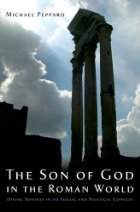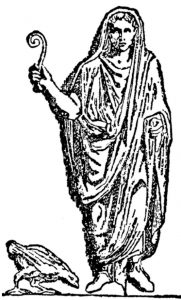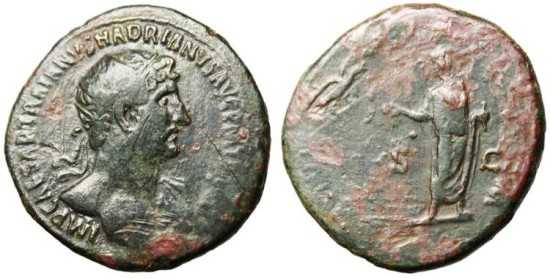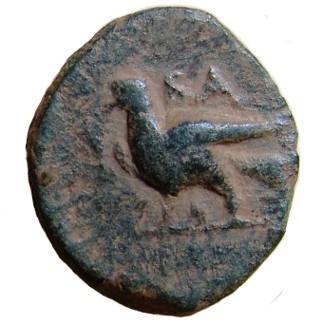 This post presents a snippet from The Son of God in the Roman World: Divine Sonship in Its Social and Political Context by Michael Peppard. There is much more in this book that deserves closer attention and that will probably be given in the coming year. Till then, I think some of us may be interested in the following.
This post presents a snippet from The Son of God in the Roman World: Divine Sonship in Its Social and Political Context by Michael Peppard. There is much more in this book that deserves closer attention and that will probably be given in the coming year. Till then, I think some of us may be interested in the following.
At one point Peppard “tries to imagine how a listener attuned to Roman culture might understand the dove”, the bird associated* with the Spirit as it descended from heaven at the baptism of Jesus. (Peppard’s approach stands in contrast to most interpretations in that they have sought to explain the dove in terms of Palestinian and Babylonian Jewish traditions.) After discussing bird omens in Roman culture generally, he comes to a survey of the dove in particular. In Roman literature the dove was often regarded as standing in opposition to the eagle, that bird of prey well known as the symbol of Roman imperial power.
Romans Read Omens Like Jews Read Scriptures
One could say that Romans used omens to interpret and explain their experience of the world in analogous ways to how Jews used Scriptures to interpret and explain their experience of the world. (The Son of God in the Roman World, p. 116)

There were the official readings of the flights of birds in the quadrants of the sky by colleges of augurs. There were also interpretations of individual flights of birds that were sanctioned by common opinion.
As for the meaning of the dove descending at the baptism of Jesus, Peppard suggests the widely varying views found in the literature are possibly the consequence of scholars failing to study this image within the full range of the cultural milieu of the earliest evangelist and his readers.
Peppard brings forward “the Roman historian and collector of tales” Suetonius. In his several “lives of the emperors” Suetonius speaks of many bird omens, and according to Peppard, they are all related to two themes, “and two only”:
the rise of imperial power and the fall from it. (p. 116)
Two examples:
Claudius entered on his belated public career as Gaius’s colleague in a two-months’ consulship; and when he entered the Forum with the consular rods, an eagle swooped down and perched on his shoulder. (Suetonius, Claud. 7)
At Bononia, where the army of the Triumvirs Augustus, Antony, and Lepidus was stationed, an eagle perched on Augustus’s tent and defended itself vigorously against the converging attack of two ravens, bringing both of them down. This augury was noted and understood by the troops as portending a rupture between their three leaders, which later took place. (Suetonius, Aug. 94)
The Bird, the Adoption and the Transfiguration
A major theme Peppard addresses is that in the era when Mark was written Roman imperial power was passed on through adoption. Peppard argues that adoption into sonship of the divine emperor was by no means a “second-class” familial relationship, but one of the highest honour. Many readers will be aware that the Gospel of Mark introduces Jesus at the moment of his adoption as a son by God himself. While this is a theme to be discussed at more length in another post, it is important to elaborate on the first historic peaceful transfer of power through adoption.
Augustus’s rise to power brought to an end a century of internal warfare. What was to happen at the end of his reign and how could a peaceful transfer of power be assured?
Look at the final omens Suetonius records that were a sign that Tiberius was to become the next emperor:
A few days before his recall an eagle, a bird never before seen in Rhodes, perched upon the roof of his house; and the day before he was notified that he might return, his tunic seemed to blaze as he was changing his clothes. (Suetonius, Tib. 14)
The two final signs that Tiberius was about to become emperor were a bird and a transfiguration of his tunic. Peppard draws the comparison with the baptism and transfiguration of Jesus.

Peppard is working within the paradigm of a first century date for the Gospel of Mark. Of particular interest, however, for those who hold out for the possibility of a second century date, in particular in relation to the time of the Bar Kochba rebellion, he also describes a coin commemorating Hadrian’s adoption by the divine Trajan, thus sealing his own destiny as emperor:
The divine election [of Hadrian] . . . was later symbolized on Hadrian’s coinage (sestertii and dupondii) of 119 C.E., which depicted an eagle flying down to Hadrian with a scepter in its talons. Fears interprets the eagle as the messenger of Jupiter, delivering imperial power to Hadrian, while Arthur Darby Nock interprets it as the apotheosis of Trajan. In either case, the legend “PROVIDENTIA DEORUM” evokes the divine participation in Hadrian’s election. Jupiter and [the divine] Trajan were working together. (p. 72)
Eagles and Doves
Peppard cites several other similar instances. One of these is the moment the rebellious Jews “captured an Eagle”, a Roman standard, thus sealing their doom.
One episode is of particular interest because it combines the motifs of imperial adoption and a dove symbol. Julius Caesar was suddenly made aware of the moment he would adopt his grand-nephew, Octavian (the future Augustus), to be his son and successor.
As the Deified Julius was cutting down a wood at Munda and preparing a place for his camp, coming across a palm tree, he caused it to be spared as an omen of victory. From this a shoot at once sprang forth and in a few days grew so great that it not only equalled the parent tree, but even overshadowed it; moreover many doves built their nests there, although that kind of bird especially avoids hard and rough foliage. Indeed, it was that omen in particular, they say, that led Caesar to wish that none other than his sister’s grandson should be his successor. (Suetonius, Aug. 94)
The primary image is of the fast-shooting branch, a common symbol of successful progeny. The doves seem to function as a decorative extra — do they represent their common association (even in ancient times) with peacefulness, suggesting a peaceful reign of Octavian to follow the period of the “rough foliage” of the civil wars, or do they represent the bird of Venus Genetrix, the mother of Aeneas, the founder of Julius Caesar’s “clan”?
There is nothing ambiguous about the role of eagles in these omens, however. They represent the imperial power of Rome.
Doves and Romans

What sorts of symbolism did Romans attribute to doves?
Firstly, Romans sometimes associated the dove in particular with Syria-Palestine. Literary artists like Tibullus and Lucian speak of the white dove as sacred to Syria-Palestine. There may have been a wider knowledge of a dove and pigeon industry in the area that bred them for sacrifices. Roman era coins minted in Ashkelon frequently depict doves.
Secondly and more importantly, the symbolism of the dove was very often associated as a foil to the symbolism of the eagle. Peppard compares the wolf and the lamb. One is the mighty predator, the other the timid victim.
“O Nymph, daughter of Peneus, stay, I entreat thee! I am not an enemy following thee. In this way the lamb {flies} from the wolf; thus the deer {flies} from the lion; thus the dove flies from the eagle with trembling wing; {in this way} each {creature flies from} its enemy: love is the cause of my following thee.
Horace, Odes 4.4, writing of how “the fatherly Augustus is . . . imagined as an eagle that produced a succession of warlike eagles in the Julio-Claudian “dynasty”:
By the brave and good, are the brave created: their sire’s virtues exist in horses and men, while the ferocious golden eagles don’t produce shy doves
Fronto, in a letter to emperor Marcus Aurelius, refers to “sheep and doves with wolves and eagles” as part of the legend of Orpheus. The reference to these archetypal enemies is a praise to Aurelius for bringing peace and harmony to the empire.
And so forth.
Other examples could be brought to confirm the contrast of eagle and dove in the Roman worldview. . . . [T]he bellicose eagle was the primary symbol of Roman military might and concomitantly of the Roman imperial ideology, while the dove was a contrasting symbol of nonviolence or fear. (p. 119)
Doves and Jews
Outside the Bible we find the same symbolic roles of eagles and doves.
Josephus in Book 17 of Antiquities speaks of the role of the Eagle standard in Jerusalem and the various reactions (Jewish and Roman) to it as the symbol of Roman power. In Book 3 of his Wars of the Jews Josephus again speaks of the meaning of the Roman eagle: it is the “king” of birds, the “most warlike”, a “sure sign of empire”, an omen of victory. The Roman legionaries viewed their Eagle standard as their very own divine power.
The apocalypse of 4 Ezra (chapter 11 and chapter 12) reinterprets the fourth beast of Daniel 7, the most terrifying of the beasts, as a symbol of Rome (it has originally symbolized the Macedonian empire) and describes it as an eagle.
Earlier in 4 Ezra we read that God has likened Israel, his own people, to a dove and a sheep:
And of all the fowls that are created thou hast named thee one dove: and of all the cattle that are made thou hast provided thee one sheep (5:26)
In Pseudo-Philo we find the dove as a symbol of Israel and of the spirit of forgiveness and mercy. See 39:5 where he interprets the story of Jephthah:
Let the dove instruct thee, whereunto Israel was likened, for though her young be taken away from her, yet departeth she not out of her place, but spurneth away her wrong and forgetteth it as it were in the bottom of the deep.
Finally in the Letter of Aristeas we see the dove being portrayed as a symbol of
gentleness, purity, and even righteousness among the birds of the air, as opposed to the eagle, which is the abomination among birds in the Torah. Israelites are called to “practice righteousness,” like the dove, and not “achieve anything by brute force,” like the eagle. (p. 121, see para 139 ff)
So how did the first readers understand the dove at Jesus’ baptism?

So Peppard offers a new way of interpreting the dove in Jesus’ baptism scene. Did ancient readers interpret Mark this way? Peppard wisely says we cannot know. The reason is that we have “so few” very early commentaries on Mark. The Gospel of Mark may have been the first of the Gospels to be written, but it was soon eclipsed by the Gospels of Matthew and John. I suspect Peppard is right for suggesting that the main reason for this was its adoptionist view of Jesus. The author of this gospel was tasked with crafting the first story of the Son of God on earth and in all likelihood used as his model, Peppard argues, the cultural beliefs of how “sons of gods” were made so. Divine emperors made them sons by adopting them as their heirs.
I like Peppard’s idea here. Well it is at least interesting and worth some thought. We know the Gospel of Mark undermines Roman ideology with several barbs. One of these is the demons named Legion who were driven, like Pharaoh’s chariots, beneath the sea. The progression of Jesus to his crucifixion have also been understood as a counterpoint to the Roman Triumph.
If we take that last point to heart — that Jesus’ ascent to the “Place of the Skull” functions as the antithesis of the glorification of the conquering Roman in the Capitoline, the hill named after the skulls (caput) found there when digging the foundations for the Temple of Jupiter — I think we are entitled to think of the dove that entered into and possessed** Jesus at baptism as prefiguring the suffering of Jesus. This interpretation is reinforced by Levenson’s observation that “beloved son” — and Jesus was identified as the “beloved son” at his baptism — could sometimes be a technical term for the son who is to be sacrificed.
Jesus is the conquering Messiah to come, as he declares before the High Priest at his trial, but he first overcomes the demonic powers of the world by means of his passage through suffering and death. He must first become the dove of Israel cast down and slaughtered by the eagle.
———–
- Peppard disagrees with “the consensus view, namely that the spirit which descends as a dove alludes to the spirit that hovered over the face of the waters at creation (Gen 1:2). The allusion“, Peppard writes, “rests on the connection between water and spirit in the two images. This consensus view is far from perfect, since the spirit in Genesis is only linked to a bird through an interpretation of the verb (מְרַחֶ֖פֶת / ἐπεφέρετο). Was the spirit “hovering” over the waters like a bird? Genesis is not explicit. R. T. France adopts the consensus view but chooses not to speculate about the dove per se: ‘we are not aware of any ready-made dove symbolism at the time of Mark, and it seems futile to try to provide one. More probably the species of bird is not an issue, any more than it was in Gen 1:2; the dove is mentioned simply as one of the commonest and most familiar birds.’ Notice how, even as he affirms the connection with Genesis 1:1, this author reveals its tenuousness. He proposes that ‘the species of bird is not an issue, any more than it was in Gen 1:2,’ which would be a fine argument, except that there is no bird in Gen 1:2!” (p. 115)
** Mark says the Spirit entered “into” Jesus, not “upon” him:
And immediately, coming up from the water, he saw the heavens parting and the Spirit descending into [= eis: not epi (upon) as in Matthew] him like a dove. Then a voice came from heaven, You [The Spirit that has just fallen from heaven and entered and become one with Jesus?] are my beloved Son . . . And immediately the Spirit drove him into the wilderness. (Mark 1:9-12)
If you enjoyed this post, please consider donating to Vridar. Thanks!

Does the name “Titus” also mean “dove” to the Romans?
http://goo.gl/ZbZmK
So it appears. What irony if the author of the gospel was setting up a foil for the destroyer of Jerusalem in the year 70. Unfortunately I fear we may be digressing too far into the realms of speculation here, however.
Thanks so much for blogging about this book Neil.. I really want to read it.. It seems that this analysis fits perfectly with MacDonald’s and reinforces the point that the gospels are basically Greco-Roman literature more than anything else. Which, for example, would explain how Mark 1 could play fast and loose with Jewish scripture and get away with it.. At least thats my take on it.. but i havent read this one yet. anyway thanks again for bringing it to our attention.
This is a book I wnt to read. Thanaks for blogging about it, Neil.